Cover Letter
White Paper • v2.0 • From the Libra Association Members
Note to readers: The first Libra Association white paper was published in June 2019. This new Association white
paper, published in April 2020, is intended to be a stand-alone update regarding the plans of the Association.
Additionally, supporting technical papers also published in June 2019 have been edited or retired.
The Libra Association’s mission is to enable a simple global payment system and financial infrastructure
that empowers billions of people. The Association’s first step toward creating a more inclusive and innovative
financial system began in June 2019 with the announcement of the project. Our goal was to establish a
collaborative dialogue early in the journey. We have worked with regulators, central bankers, elected officials,
and various stakeholders around the world to determine the best way to marry blockchain technology
with accepted regulatory frameworks. Our objective is for the Libra payment system to integrate smoothly
with local monetary and macroprudential policies and complement existing currencies by enabling new
functionality, drastically reducing costs, and fostering financial inclusion.
The Association has made changes to its initial approach, many of which depart from the approaches
taken by other blockchain projects. The Association’s goal was never to emulate other systems, but rather
to leverage the innovative approach of using distributed governance through Association Members and
distributed technology to create an open and trustworthy system. By undertaking the difficult work of
enhancing traditional financial systems to become programmable, interoperable, and upgradeable, we hope
to allow others to leverage our efforts to build innovative but also safe and compliant financial applications
that can serve everyone. We appreciate the discussions with policymakers around the world who have helped
us understand key concerns so that we can integrate actionable improvements into the Libra payment
system’s design and into a phased rollout plan.
This updated white paper outlines the significant work we have done on the design of the Libra payment
system since June 2019. Four key changes have been made to address regulatory concerns that deserve
specific attention, each of which is addressed briefly below and then in more depth in the updated
white paper:
1. Offering single-currency stablecoins in addition to the multi-currency coin.
2. Enhancing the safety of the Libra payment system with a robust compliance framework.
3. Forgoing the future transition to a permissionless system while maintaining its key
economic properties.
4. Building strong protections into the design of the Libra Reserve.
1 / 29
�
Offering single-currency stablecoins in addition to the multi-currency coin
While our vision has always been for the Libra network to complement fiat currencies, not compete with them,
a key concern that was shared was the potential for the multi-currency Libra Coin (≋LBR) to interfere with
monetary sovereignty and monetary policy if the network reaches significant scale and a large volume of
domestic payments are made in ≋LBR. We are therefore augmenting the Libra network by including single-
currency stablecoins in addition to ≋LBR, initially starting with some of the currencies in the proposed
≋LBR basket (e.g., LibraUSD or ≋USD, LibraEUR or ≋EUR, LibraGBP or ≋GBP, LibraSGD or ≋SGD). This will
allow people and businesses in the regions whose local currencies have single-currency stablecoins on
the Libra network to directly access a stablecoin in their currency. Each single-currency stablecoin will be
fully backed by the Reserve, which will consist of cash or cash equivalents and very short-term government
securities denominated in that currency. We hope to work with regulators, central banks, and financial
institutions around the world to expand over time the number of single-currency stablecoins available on
the Libra network. ≋LBR will not be a separate digital asset from the single-currency stablecoins. Under this
change, ≋LBR will simply be a digital composite of some of the single-currency stablecoins available on
the Libra network. It will be defined in terms of fixed nominal weights, such as the Special Drawing Rights
(SDR) maintained by the International Money Fund (IMF). ≋LBR can be used as an efficient cross-border
settlement coin as well as a neutral, low-volatility option for people and businesses in countries that do
not have a single-currency stablecoin on the network yet. This approach has the added benefit of allowing
the network to support a wider range of domestic use cases and of providing a clear path for seamlessly
integrating central bank digital currencies (CBDCs) as they become available. For more details, click here.
Enhancing the safety of the Libra payment system with a robust compliance
framework
Our goal is to develop a system designed to ensure compliance with applicable laws and regulations while
supporting our objectives of openness and financial inclusion. Integrated safeguards enable people and
businesses to trust the security and integrity of the Libra payment system. The Association has incorporated
feedback from regulators and continues to develop a comprehensive framework for financial compliance and
network-wide risk management as well as strong standards for Anti-Money Laundering (AML), Combating
the Financing of Terrorism (CFT), sanctions compliance, and the prevention of illicit activities. This includes
the establishment of a Financial Intelligence Function (FIU-function) to help support and uphold operating
standards for network participants. The Libra network distinguishes between four categories of participants:
(i) Designated Dealers; (ii) Virtual Asset Service Providers (“VASPs,” including exchanges and custodial wallets)
that are registered or licensed as VASPs in a Financial Action Task Force (FATF) member jurisdiction, or are
registered or licensed in a FATF member jurisdiction and are permitted to perform VASP activities under such
license or registration (Regulated VASPs); (iii) VASPs that have completed a certification process approved
by the Association (Certified VASPs); and (iv) all other individuals and entities seeking to transact or provide
services through the Libra network (Unhosted Wallets). Unhosted Wallets enable financial inclusion, broad
competition, and responsible innovation and thus facilitate the creation of services for the unbanked and
underbanked. Since their activities may pose a greater risk, they will be subject to balance and transaction
limits. Initially, the network will only be accessible to Designated Dealers and Regulated VASPs while the
Association continues to develop its certification process for other VASPs and its compliance framework
for Unhosted Wallets based on the feedback received from regulators. The Association intends to make the
network accessible to Certified VASPs and Unhosted Wallets once the relevant compliance frameworks have
been finalized. For more details, click here.
2 / 29
�
Forgoing the future transition to a permissionless system while maintaining its key
economic properties
Regulators raised thoughtful questions about the perimeter of control for the Libra network — in particular,
the need to guard against unknown participants taking control of the system and removing key compliance
provisions. We believe it is possible to replicate the key economic properties of a permissionless system
through an open, transparent, and competitive market for network services and governance, all while
incorporating the robust due diligence of Members and validators that is inherent to a permissioned system.
For more details, click here.
Building strong protections into the design of the Libra Reserve
We have had constructive discussions with regulators on how to handle extreme situations — in particular,
how the Reserve would function in stressed scenarios and what claims and protections are in place for Libra
Coin holders. We have incorporated strategies in the design and structure of the Reserve that are based on
approaches in other systems. The Reserve will hold assets with very short-term maturity, low credit risk, and
high liquidity. It will also maintain a capital buffer. For more details, click here.
This updated Libra white paper documents the mission and mechanisms supporting the Libra payment
system while seeking to provide greater detail on key areas of importance. Furthermore, we hope this
document opens the door to building broader public-private partnerships with the shared goals of advancing
global payments efficiency and expanding financial inclusion.
3 / 29
�
Introduction
The advent of the internet and mobile broadband has empowered billions of people globally by providing
access to the world’s knowledge and information, high-fidelity communications, and a wide range of
lower-cost, more convenient services. These services are now accessible using a $40 smartphone from
almost anywhere in the world.1
Despite this connectivity, large swaths of the world’s population are left behind — 1.7 billion adults globally
remain outside of the financial system with no access to a traditional bank, even though one billion have a
mobile phone and nearly half a billion have internet access.2 For too many, parts of the financial system look
like pre-internet telecommunication networks. Twenty years ago, the average price to send a text message
in Europe was 16 cents per message.3 Prices were high but were the same for everyone. Today, people with
less money pay more for financial services. Hard-earned income is eroded by fees, from remittances and
wire costs to overdraft and ATM charges.
Blockchains have a number of unique properties that can potentially address some of the problems of
accessibility and trustworthiness. These include distributed governance, which ensures that no single entity
controls the network; open access, which allows anybody with an internet connection to participate; and
security through cryptography, which protects the integrity of funds. But existing blockchain systems have
yet to reach mainstream adoption. Mass-market usage of existing blockchain-based currencies has been
hindered by their volatility and lack of scalability, which have, so far, made them poor mediums of exchange.
We believe that it is possible to combine the best aspects of blockchain-based technological
innovation — distributed governance, open access, and security — with a robust compliance and
regulatory framework. Building certain compliance requirements at the Libra protocol level can improve
the effectiveness of programs like prevention of illicit activities or Anti-Money Laundering (AML), Combating
the Financing of Terrorism (CFT), and sanctions compliance. Developers, merchants, and consumers benefit
from the compliance and security that is built into the Libra network. Technological innovation conducted
in collaboration with the financial sector, including regulators and experts across a variety of industries, is
the only way to ensure that a sustainable, secure, and trusted framework underpins this new system. And
this approach can deliver a giant leap forward toward a lower-cost, more accessible, more connected global
financial system.
The opportunity
As we embark on this journey together, we think it is important to share our beliefs to align the community
and network we intend to spark around this initiative:
• We believe that many more people should have access to financial services.
• We believe that people have an inherent right to control the fruit of their legal labor.
• We believe that global, open, instant, and low-cost payment networks create immense economic
opportunities and more commerce across the world.
• We believe that people will increasingly trust distributed forms of governance.
• We believe that an open and broadly interoperable payment network should be designed and
governed with high standards of compliance.
• We believe that we all have a responsibility to help advance financial inclusion, support ethical actors,
and continuously uphold the integrity of the payment system.
4 / 29
�
The Libra Payment System
The world needs a reliable and interoperable payment system that can deliver on the promise of “the internet
of money.” Securing your financial assets on your mobile device should be simple and intuitive. Moving
money around globally, and in a compliant way, should be as easy and cost-effective as — and even safer
and more secure than — sending a message or sharing a photo, no matter where you are, what you do, or
how much you earn. New product innovation and additional entrants lower barriers to access and facilitate
frictionless payments for more people.
Now is the time to create a new kind of digital infrastructure built on the foundation of blockchain technology.
The Libra mission is to enable a simple global payment system and financial infrastructure that empowers
billions of people. The Libra project will be made up of three parts that work together to create a more inclusive
financial system:
• A secure, scalable, and reliable blockchain as the technological backbone of the payment system;
• Libra Coins that are backed by the Libra Reserve of assets made up of cash or cash equivalents and
very short-term government securities; and
• Governance by the independent Libra Association and its subsidiary Libra Networks, tasked with
developing and operating the payment system.
The Libra payment system is built on the Libra Blockchain. Because it is intended to address a global
audience, the software that implements the Libra Blockchain is open source — designed so that anyone can
build on it, and billions of people can depend on it for their financial needs. Imagine an open, interoperable
payment system that developers and organizations build to help people and businesses hold and transfer
Libra Coins for everyday use. With the proliferation of smartphones and wireless data, more people are
coming online and will be able to access the Libra payment system. To enable the Libra network to achieve
this vision over time, the Libra Blockchain has been built from the ground up to prioritize scalability, security,
efficiency in storage and throughput, as well as future adaptability. Keep reading for an overview of the Libra
payment system, or read more about the Libra Blockchain here.
The Libra payment system will support single-currency stablecoins (e.g., ≋USD, ≋EUR, ≋GBP, etc.) and a
multi-currency coin (≋LBR), which we refer to together as Libra Coins. Libra Coins will need to be accepted in
many places and easy to access for those who want to use them. People need to have confidence that they
can use Libra Coins and that their value will remain relatively stable over time. To accomplish this, each single-
currency stablecoin will be backed 1:1 by the Reserve, which will consist of cash or cash equivalents and very
short-term government securities denominated in the relevant currency. Each ≋LBR, being a composite of
1:1-backed single-currency stablecoins supported by the Libra network, inherits the backing and stability
of those stablecoins. The Libra Reserve will be administered to preserve the value of Libra Coins over time.
Keep reading for an overview of the Libra Association, or read more about the Reserve here.
5 / 29
�
The Association is an independent membership organization headquartered in Geneva, Switzerland. The
Association’s purpose is to coordinate and provide a framework of governance decision-making for the Libra
network and Reserve, oversee the operation and evolution of the Libra payment system, facilitate the provision
of services on top of the Libra Blockchain in a safe and compliant manner, and establish social impact grant-
making in support of financial inclusion. This white paper is a reflection of our mission, vision, and purview.
Membership of the Association consists of geographically distributed and diverse businesses and
nonprofit organizations.
While Facebook teams played a key role in the creation of the Association and the Libra Blockchain, they
have no special rights within the Association. On October 14, 2019, the initial Association Members signed
on to the Association Charter. This marked the formalization of the Association Council, which is made up
of one representative per Member organization. The setup is designed to ensure that each Member has the
same privileges and obligations as any other Member. In addition, the Council elected a five-member board
of directors to carry out the day-to-day management and representation of the Association. For more details
on the organization and governance of the Association, see here.
6 / 29
�
The Libra Blockchain
The goal of the Libra Blockchain is to serve as a foundation for financial services, including a new global
payment system that meets the daily financial needs of billions of people. Through the process of evaluating
existing options, we decided to build a new blockchain based on the following three requirements:
• Able to scale to billions of accounts, which requires high transaction throughput, low latency, and an
efficient, high-capacity storage system.
• Highly secure to ensure the safety of funds and financial data.
• Flexible, so that it can power future innovation in financial services.
The Libra Blockchain is designed from the ground up to holistically address these requirements and build
on the learnings from existing projects and research — a combination of innovative approaches and well-
understood techniques. This next section highlights three decisions regarding the Libra Blockchain:
1. Designing and using the Move programming language.
2. Using a Byzantine Fault Tolerant (BFT) consensus approach.
3. Adopting and iterating on widely adopted blockchain data structures.
Designing and using the Move programming language
Move is a new programming language for implementing custom transaction logic and “smart contracts”
on the Libra Blockchain. Because of the Libra Association’s goal to one day serve billions of people, Move is
designed with safety and security as the highest priorities. Move takes insights from security incidents that
have happened with smart contracts to date and creates a language that makes it inherently easier to write
code that fulfills the author’s intent, thereby lessening the risk of unintended bugs or security incidents.
Specifically, Move is designed to prevent assets from being cloned. It enables “resource types” that constrain
digital assets to the same properties as physical assets: a resource has a single owner, it can only be spent
once, and the creation of new resources is restricted.
The Move language also facilitates automatic proofs that transactions satisfy specific properties, such as the
requirement that payment transactions only change the balances of the payer and receiver. By prioritizing
these features, Move helps keep the Libra Blockchain secure. Move allows easy and secure definition of the
core elements of the Libra network, such as payment transfers and the management of validator nodes.
Lastly, Move is one way that compliance mechanisms, such as those to facilitate Travel Rule compliance and
protocol-level sanctions screening, will be built into the Libra network.
7 / 29
�
The Association is committed to implementing appropriate review and risk controls for smart contracts. At
first, only Association-approved and -published smart contracts will be able to interact directly with the Libra
payment system. Over time, the Association will explore appropriate controls to allow third-party publishing
of smart contracts.
Using a Byzantine Fault Tolerant (BFT) consensus approach
To facilitate agreement among all validator nodes on the ledger of transactions, the Libra Blockchain adopted
the BFT approach by using the Libra Byzantine Fault Tolerance (LibraBFT) consensus protocol. This approach
accomplishes three important goals. First, it builds trust in the network because BFT consensus protocols
are designed to function correctly even if some validator nodes — up to one-third of the network — are
compromised or fail. Second, this class of consensus protocols enables high transaction throughput,
low latency, and a more energy-efficient approach to consensus than “proof of work” used in some other
blockchains. And third, the LibraBFT protocol facilitates clearly described transaction finality, so when
a participant sees confirmation of a transaction from a quorum of validators, they can be sure that the
transaction has completed.
The security of BFT depends on the quality of the validators, so the Association will perform due diligence
on prospective validators. The Libra network is designed with a security-first approach and sophisticated
cyber and critical infrastructure attacks in mind. The network is structured to strengthen the assurance of
the software run by the validators, including leveraging techniques such as the separation of critical code
(a “trusted computing base”), innovative ways of testing the consensus algorithm, and careful management
of dependencies. Finally, Libra Networks will define policies and procedures for reconfiguring the Libra
Blockchain in the case of critical errors or the need for upgrades. In addition to being designed to ensure a
safe recovery of the system in these cases, this preparation will deter attacks because attackers will know
that their actions can be countered.
Adopting and iterating on widely adopted blockchain data structures
In order to securely store transactions, data on the Libra Blockchain will be protected by Merkle trees, a
data structure used by other blockchains that enables the detection of any changes to existing data. Unlike
previous blockchain projects, which view the blockchain as a collection of blocks of transactions, the Libra
Blockchain will be a single data structure that records the history of transactions and states over time. This
implementation simplifies the work of applications accessing the blockchain, enabling a unified framework
that allows for data to be read from any point in time in order to verify the integrity of that data.
One outcome of the above design decisions is that the Libra Blockchain will provide public verifiability,
meaning that anyone (validators, Libra Networks, Virtual Asset Service Providers (VASPs), law enforcement,
or any third party) can audit the accuracy of all operations. Transactions will be signed cryptographically so
that even if all validators are compromised, no falsified transactions from addresses with secure signature
keys can be accepted as committed. The design is compatible with hardware key management and off-line
storage of high-value cryptographic keys.
Another outcome of the above design decisions is that the Libra Blockchain will support a privacy approach
that will take into account the variety of participants on the network. The Association oversees the evolution
8 / 29
�
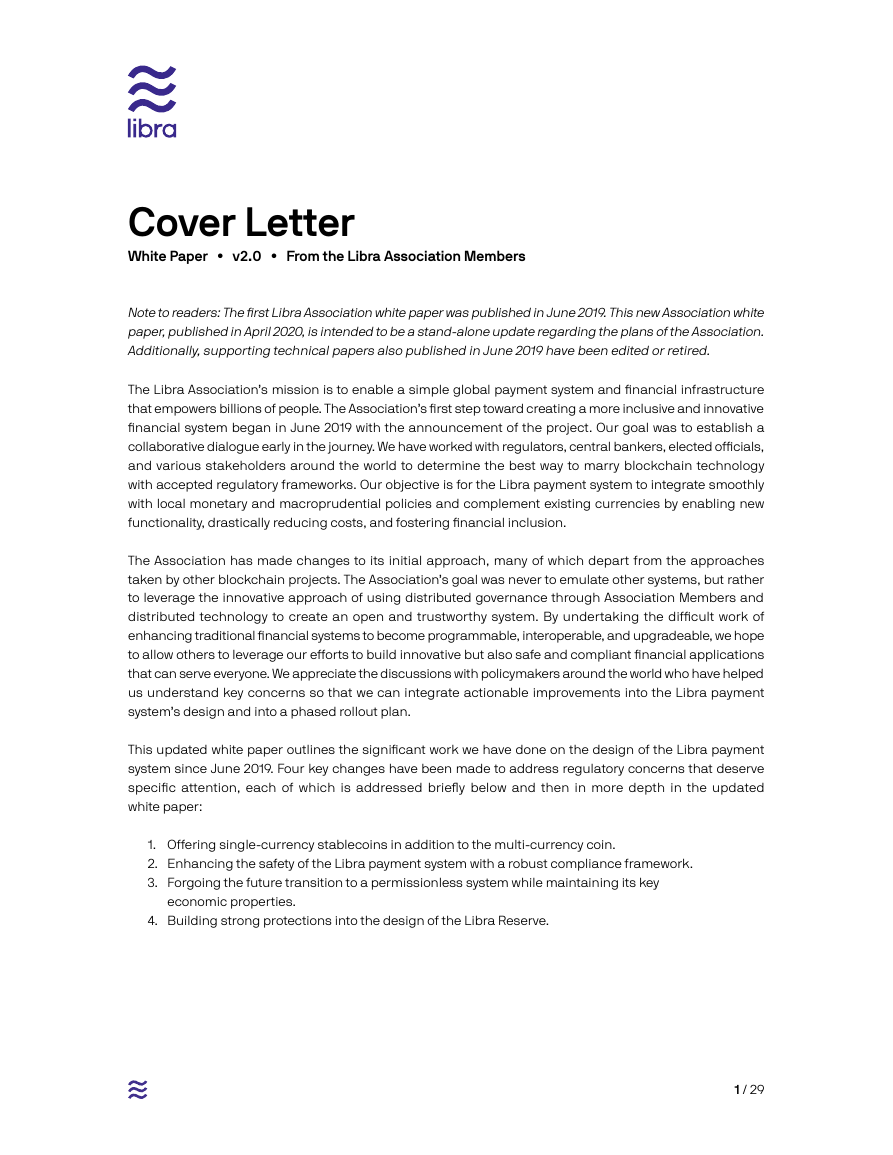
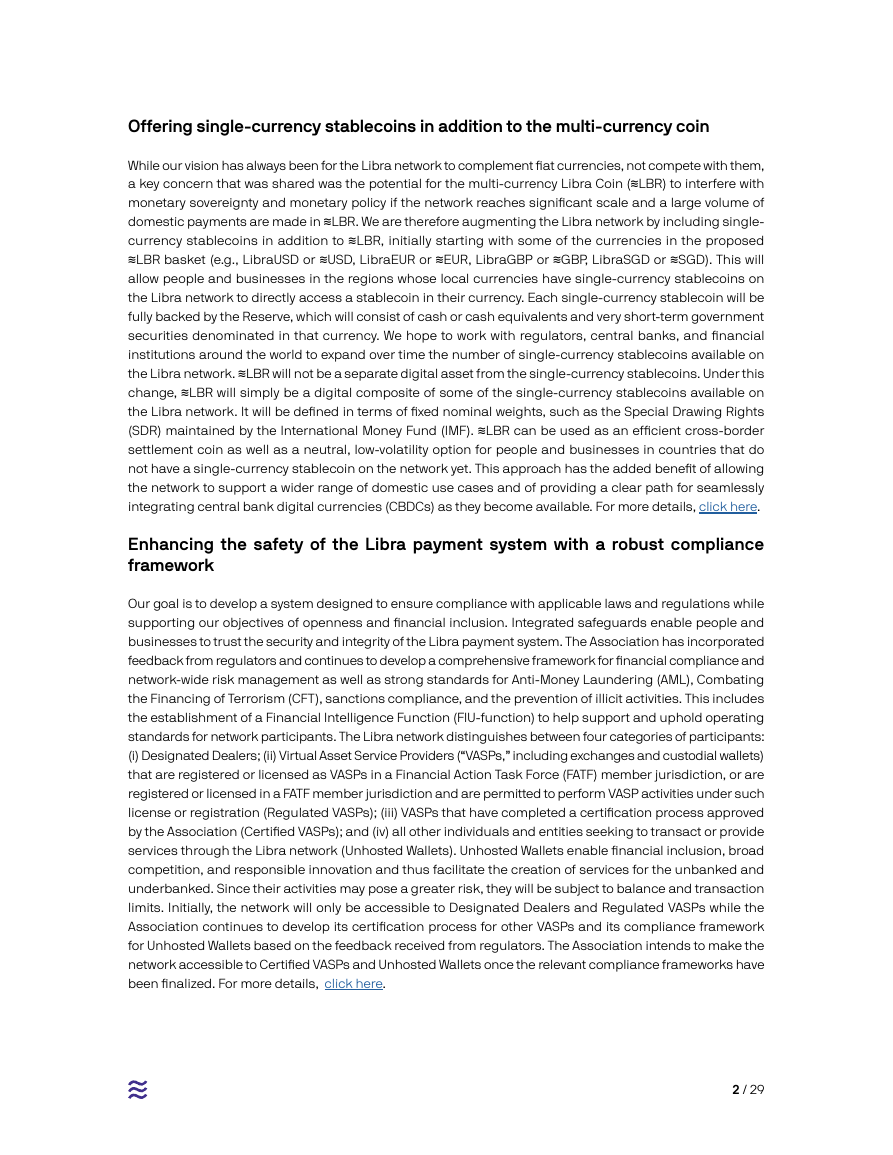
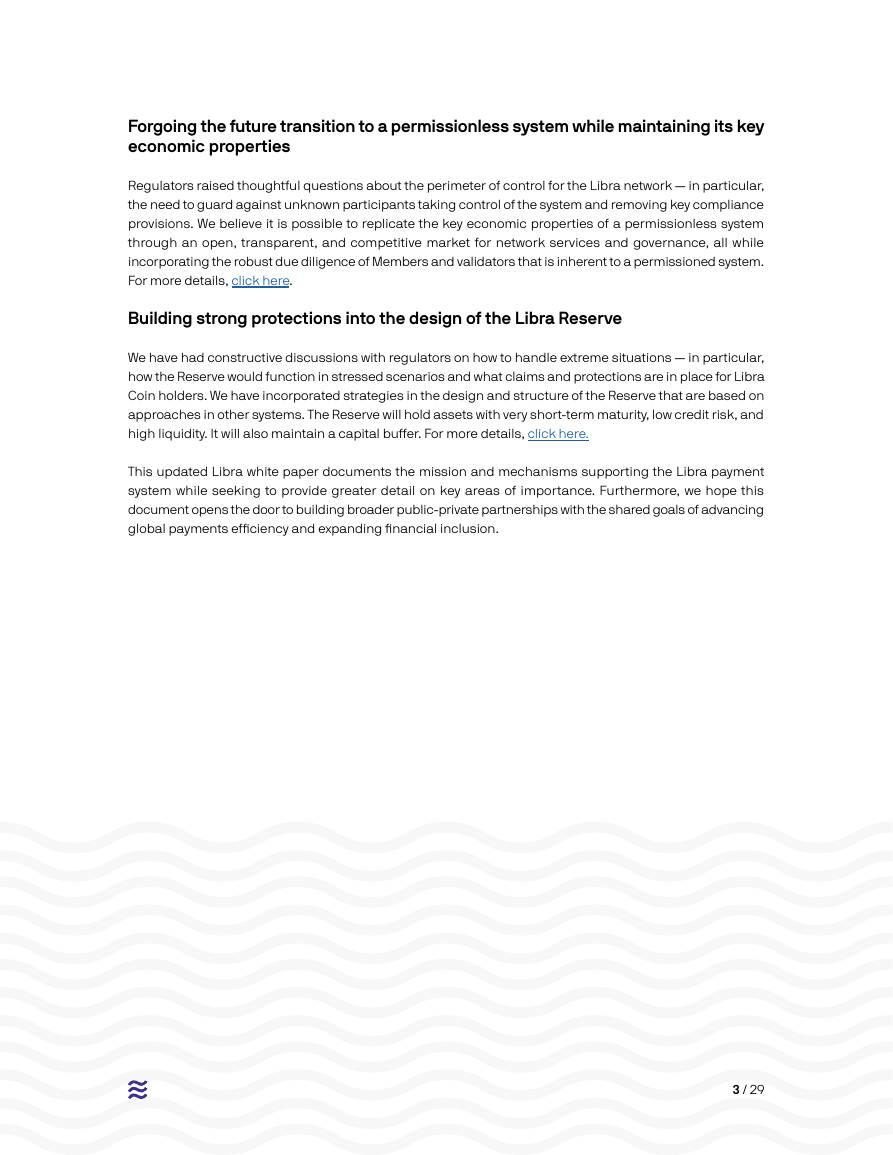
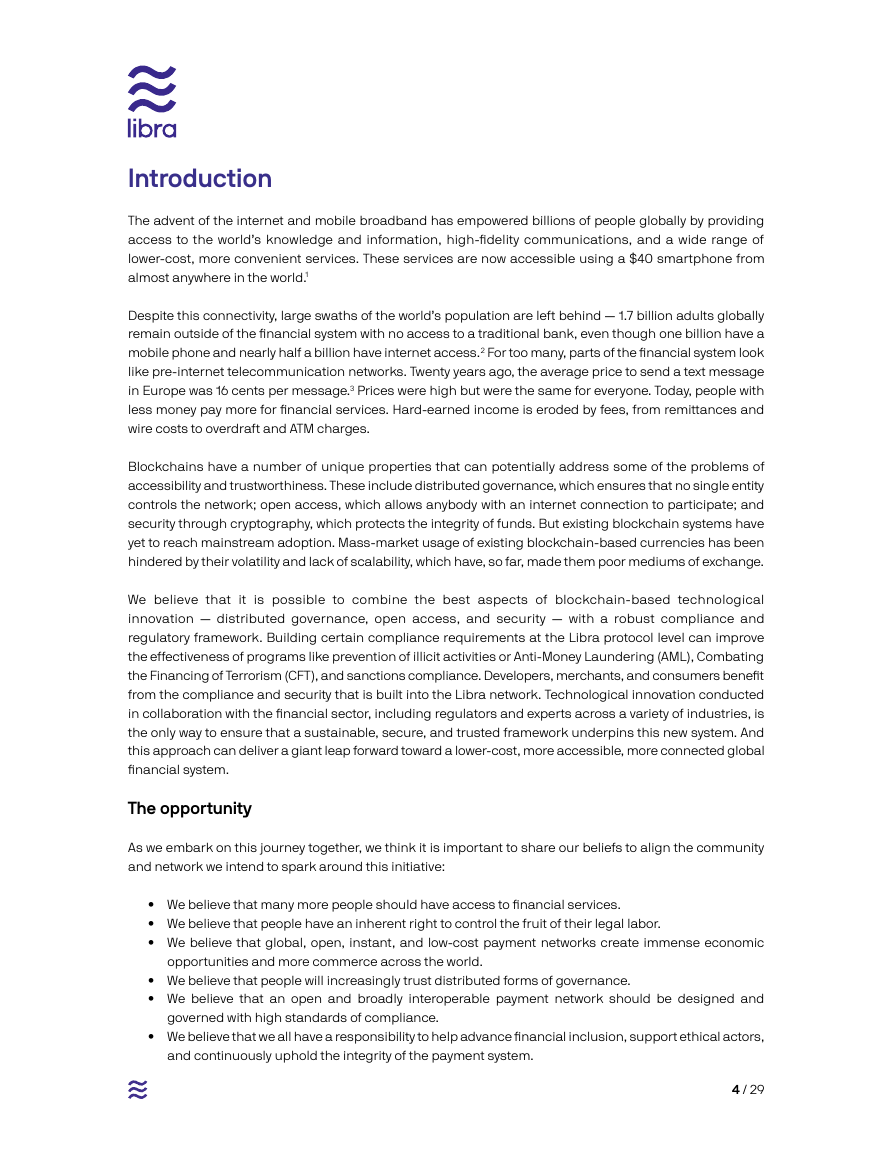
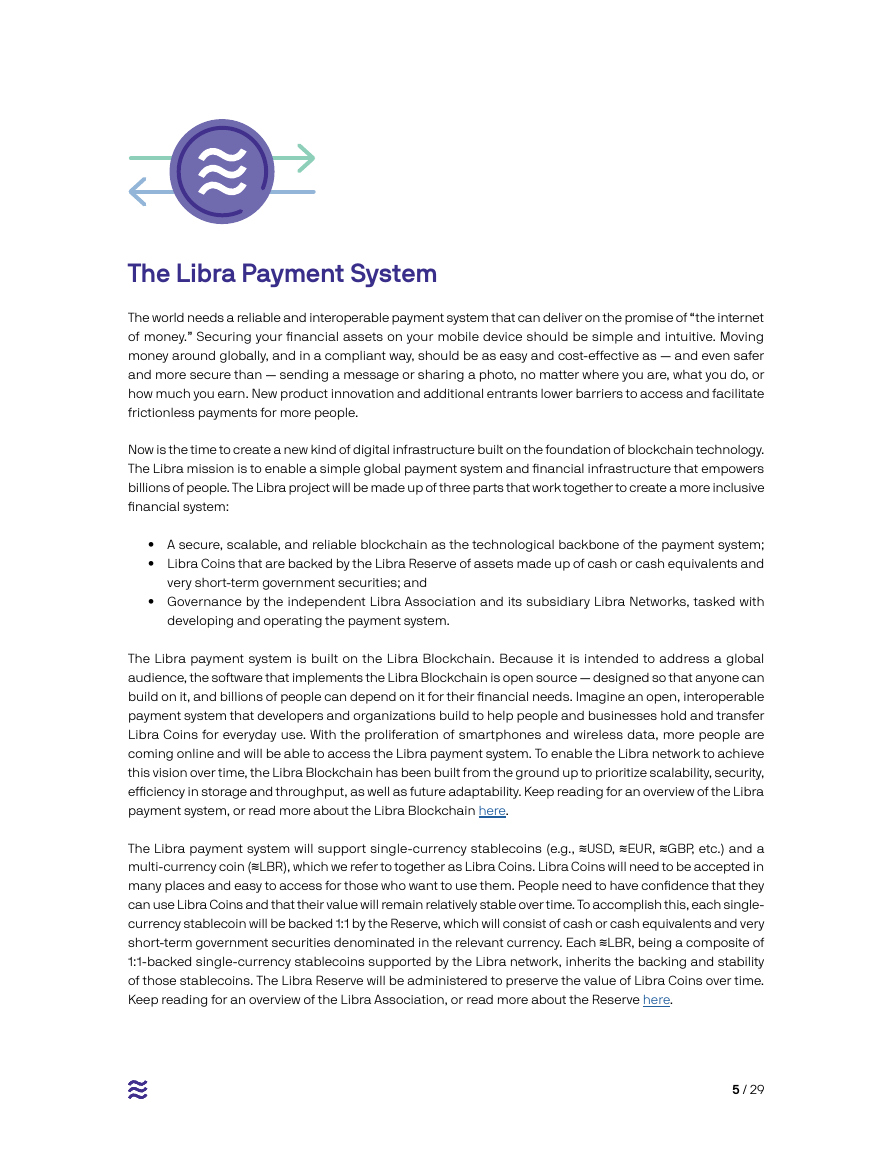
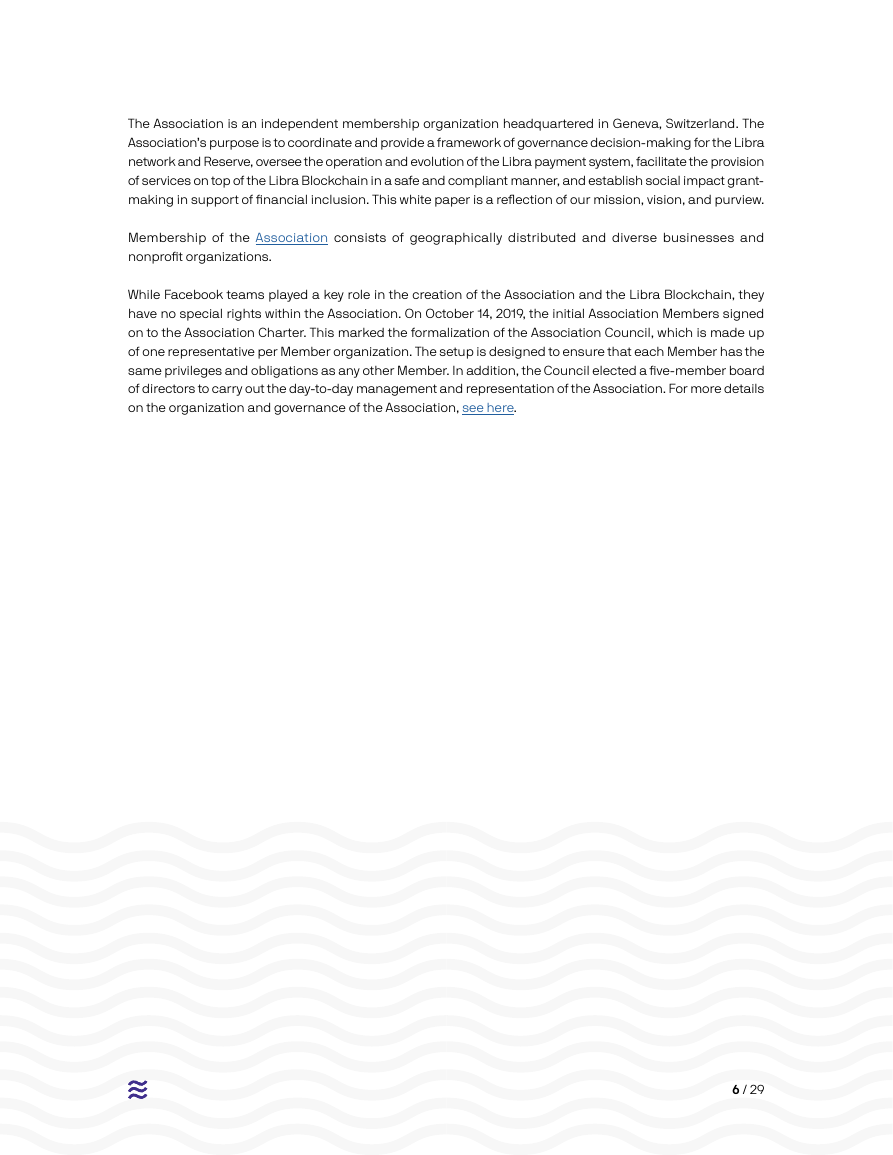
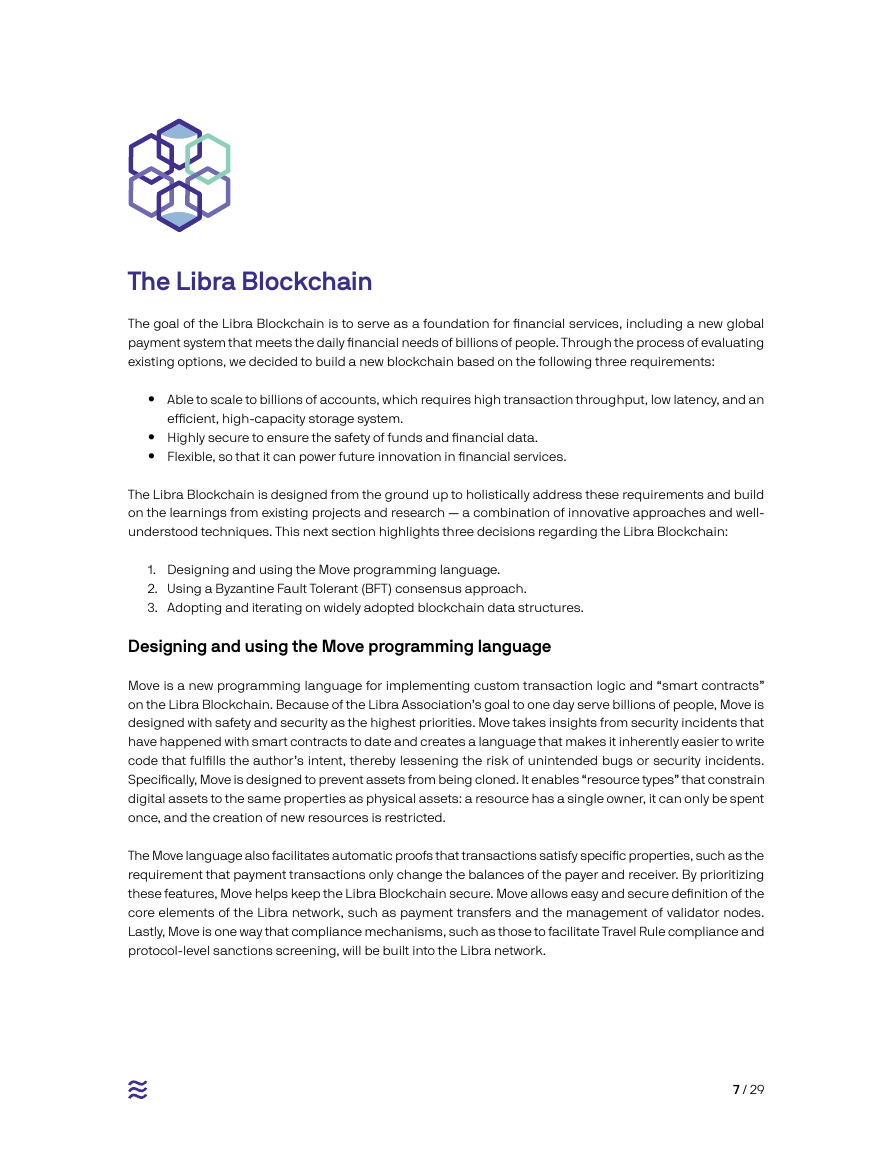









 2023年江西萍乡中考道德与法治真题及答案.doc
2023年江西萍乡中考道德与法治真题及答案.doc 2012年重庆南川中考生物真题及答案.doc
2012年重庆南川中考生物真题及答案.doc 2013年江西师范大学地理学综合及文艺理论基础考研真题.doc
2013年江西师范大学地理学综合及文艺理论基础考研真题.doc 2020年四川甘孜小升初语文真题及答案I卷.doc
2020年四川甘孜小升初语文真题及答案I卷.doc 2020年注册岩土工程师专业基础考试真题及答案.doc
2020年注册岩土工程师专业基础考试真题及答案.doc 2023-2024学年福建省厦门市九年级上学期数学月考试题及答案.doc
2023-2024学年福建省厦门市九年级上学期数学月考试题及答案.doc 2021-2022学年辽宁省沈阳市大东区九年级上学期语文期末试题及答案.doc
2021-2022学年辽宁省沈阳市大东区九年级上学期语文期末试题及答案.doc 2022-2023学年北京东城区初三第一学期物理期末试卷及答案.doc
2022-2023学年北京东城区初三第一学期物理期末试卷及答案.doc 2018上半年江西教师资格初中地理学科知识与教学能力真题及答案.doc
2018上半年江西教师资格初中地理学科知识与教学能力真题及答案.doc 2012年河北国家公务员申论考试真题及答案-省级.doc
2012年河北国家公务员申论考试真题及答案-省级.doc 2020-2021学年江苏省扬州市江都区邵樊片九年级上学期数学第一次质量检测试题及答案.doc
2020-2021学年江苏省扬州市江都区邵樊片九年级上学期数学第一次质量检测试题及答案.doc 2022下半年黑龙江教师资格证中学综合素质真题及答案.doc
2022下半年黑龙江教师资格证中学综合素质真题及答案.doc